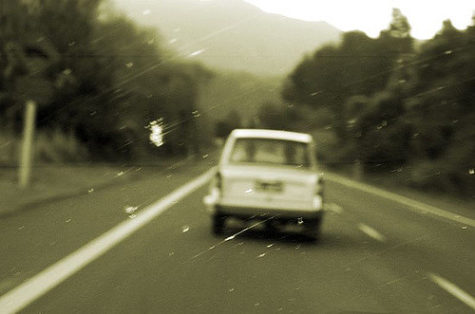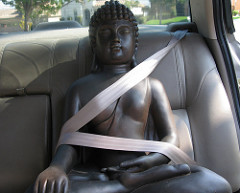 Several times in the last few weeks, I’ve found myself driving Highway 101 from Santa Barbara to Berkeley, a 320-mile route. The trip starts out along the ocean, then dips in and out of oak-dotted hills. Later, the road slices through the Salinas Valley and then into Silicon Valley.
Several times in the last few weeks, I’ve found myself driving Highway 101 from Santa Barbara to Berkeley, a 320-mile route. The trip starts out along the ocean, then dips in and out of oak-dotted hills. Later, the road slices through the Salinas Valley and then into Silicon Valley.
The last part is my least favorite—the lanes multiply, and so does the traffic. But the rest of the trip is pretty ideal. The road rolls gently beneath circling red-tailed hawks and past farms. Even the less-scenic roadside attractions make compelling landmarks—the bobbing heads of the oil derricks near San Ardo, the battered billboard on a hillside before King City. (And there’s a Starbucks almost exactly halfway between my start and end points. At home I avoid the place, but three hours on the road and it becomes a green oasis. There’s even a drive through.)
I guess those are the qualities that make a good road tripping road for me: interesting things to look at, easy driving, and a good place to stop along the way. Last year, data scientist Randal Olson took long-distance driving up a notch by using a genetic algorithm to find the optimal road trip across the 48 contiguous U.S. states.
His route hits at least one landmark in every state, from the Statue of Liberty in New York to the Grand Canyon in Arizona. Some of the sights are less iconic than others (there’s plenty of grumbling in the comments about what important spots were missed in various states). Without traffic, the journey takes 224 hours of straight driving, which makes my little six-to-eight hour haul seem like a hop, skip and a jump. Olson has since tested out different routes—major cities in each state, and state capitols—and he’s also released the code for those who want to plot their own course.
My own route is already set, so the only way to optimize it seems to be to tinker with what we bring along. But even with the best snacks and a full component of audiobooks and DVDs, I never know when one of the passengers will begin to protest. This week the reasons for our stops included the following: have to pee, dropped water bottle, diaper change, skipping DVD, just peed but have to pee again, dropped snacks, back itchy in a spot that can’t be scratched until we stop. And then, right when we’d finally gotten back on the highway after a series of false starts, someone screamed “It’s an emergency!”
My back stiffened. Whatever it was, I was not going to stop.
“My butt is stuck together! Help!”
The real optimization seems to come from changing how I think. I start the trip breaking the miles down into hours, making mental notes of when we should hit certain landmarks. But as I keep driving, the stops catch up with our perfect timing, and my calculations break down, and sometimes I find myself just enjoying the wheels spinning on the highway, the way the light hits the distant hills, the pattern dance of cars and semis passing and slowing.
The return trip often seems shorter. A study last year suggested that a return trip may feel like it takes less time because we have poor memories of the outbound journey. Other factors may be at work, too—we may need to reach our destination at a certain time, while coming back may be more leisurely. Or the first leg may seem so long that you lower your expectations when you’re heading back home.
At this point, I try not to have too many expectations. During our Tuesday emergency, I pulled off onto a gravel patch so that we could perform the unsticking operation. A highway patrol car looked on, and I wondered what the officer inside was thinking as I hunched over, one hand over my mouth, trying not to laugh and cry. I had the same feeling a few hours later, when the toddler in the back started to sing a one-word song.
Home, he said, home.
“We’re almost there,” I said. “Every minute we’re getting closer.” He kept singing, and I started up my own chorus—closer, closer, than we’ve ever been before. We kept it up until I’d almost started to believe it myself.
**
Images from Flickr users Arti Sandhu and Miheco via Flickr/Creative Commons